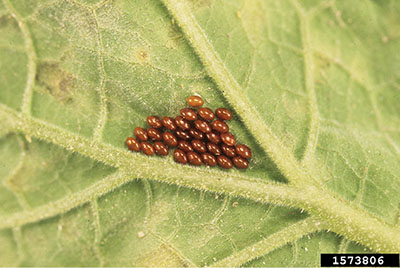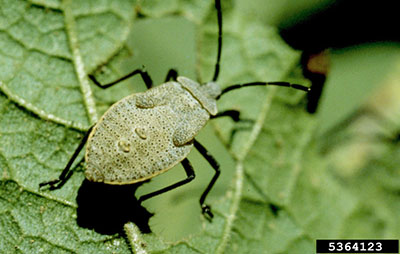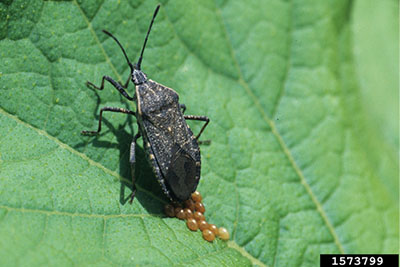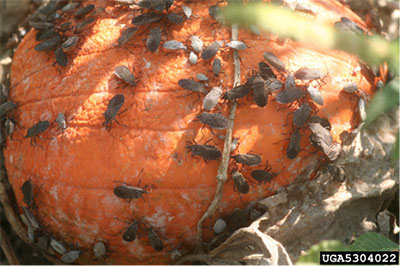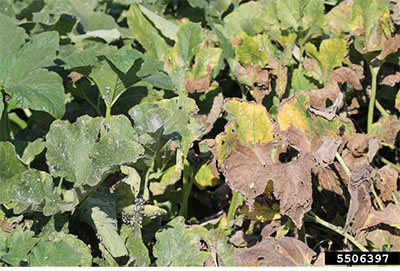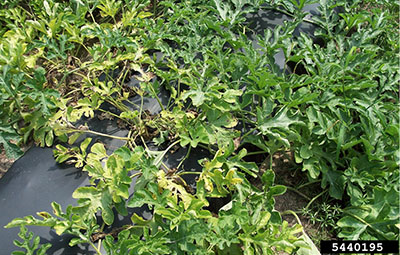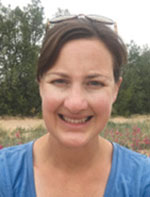Guide H-183
Amanda Skidmore, Melissa Schreiner, and Miranda L. Kersten
College of Agricultural, Consumer and Environmental Sciences, New Mexico State University
Respectively, former Extension Integrated Pest Management Specialist, Department of Extension Plant Sciences; former Research Assistant, Agricultural Science Center (ASC) at Los Lunas; and Program Manager, ASC at Los Lunas, New Mexico State University. (Print-friendly PDF)
Summary
For over 120 years, farmers and home gardeners have been battling the squash bug (Anasa tristis), a major economic pest of cucurbits (e.g., squash, pumpkins, gourds, cucumbers, melons, etc.) in New Mexico. Adult and nymph (immature stage) squash bugs damage plants through feeding and vectoring (transmitting) plant pathogens, which results in yield declines and plant death. Squash bugs are resilient and can reproduce in large numbers that can quickly overwhelm a production system or garden. This short guide outlines best management practices that producers and home gardeners can adopt for squash bug integrated pest management (IPM).
Note about using this guide: Throughout this guide, “home garden” refers to small-scale growers who have fewer than 20 cucurbit plants or less than 1/8 acre. Some management practices that are suitable for small-scale growers are not practical for growers managing larger, production-level operations.
Life Cycle and Biology
In New Mexico, squash bugs can have multiple generations per year. In northern or higher-elevation regions of the state, 1 to 1 1/2 generations can occur during the growing season. In warmer regions of the state, 2 to 3 generations may occur. Adults overwinter in plant debris, compost piles, or other protected areas, such as tree trunks or buildings/structures. In the spring when the temperatures warm to above 50°F (10°C), adult squash bugs will begin searching for host plants. Females lay copper- to black-colored eggs in clusters on the undersides of leaves where leaf veins meet (Figure 1). Newly hatched nymphs are bright green and look like extra-large aphids (Figure 2). As squash bug nymphs mature and molt, their bodies become tear-shaped and dusty-grey in color. Adults are dark grey-brown with white markings, and are about 1 to 1 1/2 inches in length (Figure 3). When crushed, they release an unappealing, sweet, melon-like smell. Adults and nymphs often aggregate around the base of the plant under dead leaves, although they can be found all over the plant foliage and in flowers. Both adults and nymphs are stealthy and good at hiding, especially in areas around the base of plants.
Figure 1. Squash bug eggs (Gerald Holmes, Strawberry Center, Cal Poly San Luis Obispo, Bugwood.org).
Figure 2. Squash bug nymph (Whitney Cranshaw, Colorado State University, Bugwood.org).
Figure 3. Adult squash bug laying eggs on a squash leaf (Gerald Holmes, Strawberry Center, Cal Poly San Luis Obispo, Bugwood.org).
Damage
Squash bugs cause damage through both feeding and disease transmission. They use their piercing-sucking mouthparts to puncture holes in leaves, stems, and occasionally fruits to feed on plant tissue (Figure 4). This disrupts nutrient flow through the plants, and extreme squash bug pressure can cause wilting, yellowing, necrosis, and even plant death (i.e., “sudden wilt”; Figure 5). Feeding also releases plant stress pheromones that can attract additional pests to the plant. Squash bugs can vector plant pathogens, such as the bacterium Serratia marcescens, which causes cucurbit yellow vine disease (CYVD; Figure 6). Squash bugs feeding on infected plant tissues ingest the bacterium into their gut. The bacterium remains in them for an extended time (even in overwintering adults) and can be transmitted to healthy plants via feeding the following season. Removing plants that show signs of CYVD is encouraged in order to reduce the spread of the disease.
Figure 4. Squash bug infestation on a pumpkin (Whitney Cranshaw, Colorado State University, Bugwood.org).
Figure 5. Damage associated with squash bugs (Whitney Cranshaw, Colorado State University, Bugwood.org).
Figure 6. Watermelon showing symptoms of cucurbit yellow vine disease (Edward Sikora, Auburn University, Bugwood.org).
Integrated Pest Management (IPM)
Integrated pest management (IPM) is an approach to pest management that combines cultural, mechanical/physical, biological, and chemical control strategies in a way that minimizes economic, health, and environmental risks (USDA–ARS, 2018). It relies on pest prevention, accurate identification of pests, and monitoring of pest populations. In an IPM program, chemical controls should be considered a last resort. These strategies are combined to create an all-inclusive management plan that reduces costs and chemical use.
Prevention
Sanitation is key for preventing squash bugs from overwintering and impacting early spring plantings. Cleaning up old plant material from the garden or field (through removal or tillage) reduces overwintering habitat. Plant material should be bagged, burned, or composted. If composted, whole plants and large leaves should be cut up to prevent pockets where pests can survive.
Plant selection also helps in deterring squash bugs. Some species of cucurbits are more susceptible to squash bugs, especially squashes and pumpkins. Squash bugs are less attracted to cantaloupe, cucumbers, and watermelons, but can be problematic in these crops in years with high squash bug pressure.
Monitoring
For home garden plantings, monitor at least 20% of the plants. Egg surveys should be done at least once a week during June when egg laying is likely to begin. Plants should be searched thoroughly for squash bug adults, nymphs, and eggs. Check the front and back of green leaves, leaf undersides and leaf veins (for egg clusters), and under old foliage at the base of the plant. If plastic mulch or landscape fabric is being used for weed management, search the edges around planting holes since these are protected areas where squash bugs will hide; scout for smaller nymphs and egg masses on flowering plants. Squash bug adults and nymphs have been observed to actively hide in the field and often go undetected because they will move away from the approaching gardener or farmer.
The action threshold for squash bug management is one egg cluster or one adult per plant. The threshold can be calculated by dividing the number of squash bugs and egg masses observed by the number of plants scouted.
number of egg masses + number of adults/nymphs
___________________________________
number of plants scouted
For example, if 20 plants are scouted and 10 squash bugs are found, there are an estimated 0.50 bugs per plant (10 squash bugs / 20 plants), and therefore no treatment would be recommended. If 20 plants are scouted and 10 egg masses and 20 squash bugs are found, there are about 1.5 squash bugs or egg masses per plant [(10 egg masses + 20 squash bugs) / 20 plants)], and treatment would be recommended.
Cultural Control
Adjusting the timing of planting, crop rotation, and sanitation are some strategies that can be used to manage squash bugs. Plant fast-maturing summer squashes early, but delay planting winter squashes by a couple of weeks until later in the growing season (mid-July) to help avoid infestations of squash bugs. Rotating your planting to a new field/garden bed, as far away as possible from the one used in the previous year, can reduce how quickly squash bugs migrate into the new field. Cucurbits benefit from the use of mulches because they suppress weeds and help with soil water retention; however, mulches may harbor squash bugs. Avoid dense plantings and overwatering when mulching your cucurbits. Removing debris after harvest from around the field/garden bed can kill overwintering squash bugs and reduce the following year’s population. Companion planting with alliums, mints, and African marigolds can help to repel squash bugs. Remove weeds and dead plant material throughout the growing season to reduce squash bug refuges in the field.
Mechanical Control
Early season row covers, such as thin cloth or screens, can reduce squash bug access to plants. This is a common and important practice within organic production. Row covers can be a productive way to protect young plants for the first 4 to 6 weeks of the growing season. They should be installed at the time of planting and sealed along the ground with dirt or rock bags. As plants grow, they can press against the row cover, exposing them to squash bug feeding and egg laying through the covers. Monitor to ensure that squash bugs have not gained access to the plants. It is important to remove covers at the time of female flowering to give pollinators access to plants. In smaller plantings, hand-picking can be an effective management strategy to control squash bug populations. Egg clusters can be crushed between gloved fingers, and nymphs/adults can be dropped into a bucket of soapy water and discarded once dead.
Home Garden Tip
Home gardeners can use damp cardboard or newspaper to trap adults and nymphs. Placing small (about 12-inch) cardboard or newspaper “tents” around the base of plants supported by rocks or wood can create a protected space that can be attractive to squash bugs. Check the traps in the morning before the heat of the day causes the squash bugs to disperse. If found, collect and crush or drop into soapy water, as described above.
Biological Control
Biological controls can help reduce populations of squash bugs and other pests, but they should not be relied upon solely for squash bug control. Several arthropod species, such as spiders, ground beetles, robber flies, and lady beetles, prey on squash bugs throughout their life cycle. Adult squash bugs have a hardened exoskeleton, making them more difficult for arthropod predators to kill than nymphs.
There are two parasitoids of squash bugs. A small parasitoid wasp (Gryon pennsylvanicum) is the main parasitoid of the squash bug. It lays its eggs inside of squash bug eggs, eventually killing the developing squash bug. Another parasitoid, a tachinid fly (Trichopoda pennipes), parasitizes adults and older nymphal stages. It lays its eggs within the body of the squash bug; the fly larvae hatch and mature within the squash bug, killing it.
Chemical Control
Chemical management is difficult with this specific pest. Pesticide applications should only be made when nymphs can be targeted early in the season, and only when all other control methods have been tried first. If spraying must occur, target nymphs on young plants before flowering occurs and before plants start vining. Pesticides are most effective when temperatures are cooler. Applications should be made in the early or late hours of the day. When squash bugs mature into adults, they become difficult to control, partly because they hide in the lower canopy near the soil, making sprays less effective. They also become armored with a thick exoskeleton.
Conventional Management
Few chemical control options are available for producers for squash bugs. Pyrethroids and azadirachtin applications can suppress squash bug populations, specifically nymphs. When large populations of squash bugs are present, these insecticides have not provided effective or consistent control in the field and are not recommended (Cranshaw, 2013).
Organic Management
Diatomaceous earth (DE) applications around the base of the plant can be an effective method to control squash bugs, and this treatment is allowed in certified organic vegetable production. DE can also be applied with a duster directly to the squash leaves.
Conclusions
Developing an IPM strategy for squash bugs is important for mitigating their impact on plant production in both small farms and home gardens in New Mexico. Choose management practices that fit your growing practices, climate, economic resources, and time. For additional help and local information, reach out to your county or Tribal Cooperative Extension Service Agent (https://aces.nmsu.edu/county/).
Resources
Bruton, B.D., J. Fletcher, S.D. Pair, M. Shaw, and H. Sittertz-Bhatkar. 1998. Association of a phloem-limited bacterium with yellow vine disease in cucurbits. Plant Disease, 82(5), 512–520.
Cranshaw, W. 2013. Squash bug: Management in home gardens [Fact Sheet No. 5.609]. Fort Collins: Colorado State University Extension. https://extension.colostate.edu/docs/pubs/insect/05609.pdf
Dogramaci, M., J.W. Shrefler, B.W. Roberts, S. Pair, and J.V. Edelson. 2004. Comparison of management strategies for squash bugs (Hemiptera: Coreidae) in watermelon. Journal of Economic Entomology, 97(6), 1999–2005.
Doughty, H.B., J.M. Wilson, P.B. Schultz, and T.P. Kuhar. 2016. Squash bug (Hemiptera: Coreidae): Biology and management in cucurbitaceous crops. Journal of Integrated Pest Management, 7(1). https://doi.org/10.1093/jipm/pmv024
Pair, S.D., B.D. Bruton, F. Mitchell, J. Fletcher, A. Wayadande, and U. Melcher. 2004. Overwintering squash bugs harbor and transmit the causal agent of cucurbit yellow vine disease. Journal of Economic Entomology, 97(1), 74–78.
USDA–ARS. 2018, September 21. A national road map for integrated pest management. https://www.ars.usda.gov/ARSUserFiles/OPMP/IPM%20Road%20Map%20FINAL.pdf
For Further Reading
H-174: Integrated Pest Management (IPM) Strategies for Common Insect Pests of Trees in New Mexico
https://pubs.nmsu.edu/_h/H174/index.html
H-176: Integrated Pest Management (IPM) Strategies for Common Garden Insect Pests of New Mexico
https://pubs.nmsu.edu/_h/H176/index.html
H-181: Integrated Pest Management (IPM) for Pollinator Conservation in Home Gardens and Small Farms
https://pubs.nmsu.edu/_h/H181/index.html
Miranda Kersten is a Program Manager with the urban integrated pest management (IPM) program at NMSU’s Agricultural Science Center in Los Lunas. Her work focuses on pollinator and beneficial insect conservation, monitoring beneficial insects across urban landscapes, and managing IPM research projects.
The pesticide recommendations in this publication are provided only as a guide. The authors and New Mexico State University assume no liability resulting from their use. Please be aware that pesticide labels and registration can change at any time; by law, it is the applicator’s responsibility to use pesticides ONLY according to the directions on the current label. Use pesticides selectively and carefully and follow recommended procedures to safely store and dispose of surplus pesticides and containers.
This work is supported by the Crop Protection and Pest Management Program (award no. 2017- 70006-27189) project accession no. 1013838 from the National Institute of Food and Agriculture.
To find more resources for your business, home, or family, visit the College of Agricultural, Consumer and Environmental Sciences on the World Wide Web at pubs.nmsu.edu.
Contents of publications may be freely reproduced, with an appropriate citation, for educational purposes. All other rights reserved. For permission to use publications for other purposes, contact pubs@nmsu.edu or the authors listed on the publication.
New Mexico State University is an equal opportunity/affirmative action employer and educator. NMSU and the U.S. Department of Agriculture cooperating.
January 2023 Las Cruces, NM


